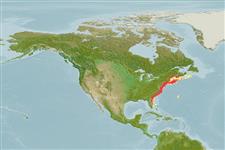Environment: milieu / climate zone / depth range / distribution range
Ecologie
marien; brak water demersaal; oceanodroom; diepte 10 - 183 m (Ref. 5951), usually ? - 37 m (Ref. 5951). Temperate; 45°N - 25°N, 81°W - 57°W
Northwest Atlantic: Maine (rarely Nova Scotia, Canada) to southern Florida, USA.
Lengte bij maturiteit / Grootte / Gewicht / Leeftijd
Maturity: Lm 28.0 range ? - ? cm
Max length : 94.0 cm TL mannelijk / geslacht onbekend; (Ref. 7251); max. gepubliceerd gewicht: 12.0 kg (Ref. 7251); max. gerapporteerde leeftijd: 9 Jaren (Ref. 52684)
Adults usually prefer hard sandy substrate where they can burrow; can exploit a broad range of lower and mid-estuary habitats including salt marsh creeks and seagrass beds, which usually have muddy or silty substrates , as well as sand flats (Ref. 26621). Occur in bays, lagoons and shallow coastal waters. Utilized fresh and frozen; can be steamed, fried, boiled, microwaved and baked (Ref. 9988). Exported fresh to Japan for sashimi.
Distinct pairing (Ref. 205).
Robins, C.R. and G.C. Ray, 1986. A field guide to Atlantic coast fishes of North America. Houghton Mifflin Company, Boston, U.S.A. 354 p. (Ref. 7251)
Status op de Rode Lijst van het IUCN (Ref. 130435)
Gevaar voor de mens
Other
Gebruik door de mens
Visserij: commercieel; sportvis: ja
Tools
Speciale rapporten
Download XML
Internetbronnen
Estimates based on models
Preferred temperature (Ref.
123201): 9.1 - 24.4, mean 19.1 °C (based on 12 cells).
Fylogenetische diversiteitsindex (Ref.
82804): PD
50 = 0.5000 [Uniqueness, from 0.5 = low to 2.0 = high].
Bayesian length-weight: a=0.00589 (0.00468 - 0.00742), b=3.17 (3.12 - 3.22), in cm total length, based on LWR estimates for this species (Ref.
93245).
Trofisch niveau (Ref.
69278): 4.5 ±0.3 se; based on diet studies.
Generation time: 5.1 ( na - na) years. Estimated as median ln(3)/K based on 1
growth studies.
Weerstandsvermogen (Ref.
120179): Gemiddeld, minimale populatieverdubbelingstijd 1,4-4,4 jaar (K=0.77-0.84(?); assuming tm>=2; tmax=9).
Prior r = 0.86, 95% CL = 0.57 - 1.30, Based on 1 stock assessment.
Fishing Vulnerability (Ref.
59153): Moderate to high vulnerability (47 of 100).
Climate Vulnerability (Ref.
125649): Moderate to high vulnerability (51 of 100).
Nutrients (Ref.
124155): Calcium = 25.9 [11.3, 42.8] mg/100g; Iron = 0.292 [0.145, 0.532] mg/100g; Protein = 16.5 [14.1, 19.7] %; Omega3 = 0.374 [0.200, 0.700] g/100g; Selenium = 16.3 [8.0, 35.8] μg/100g; VitaminA = 9.6 [2.5, 41.5] μg/100g; Zinc = 0.321 [0.219, 0.478] mg/100g (wet weight);
